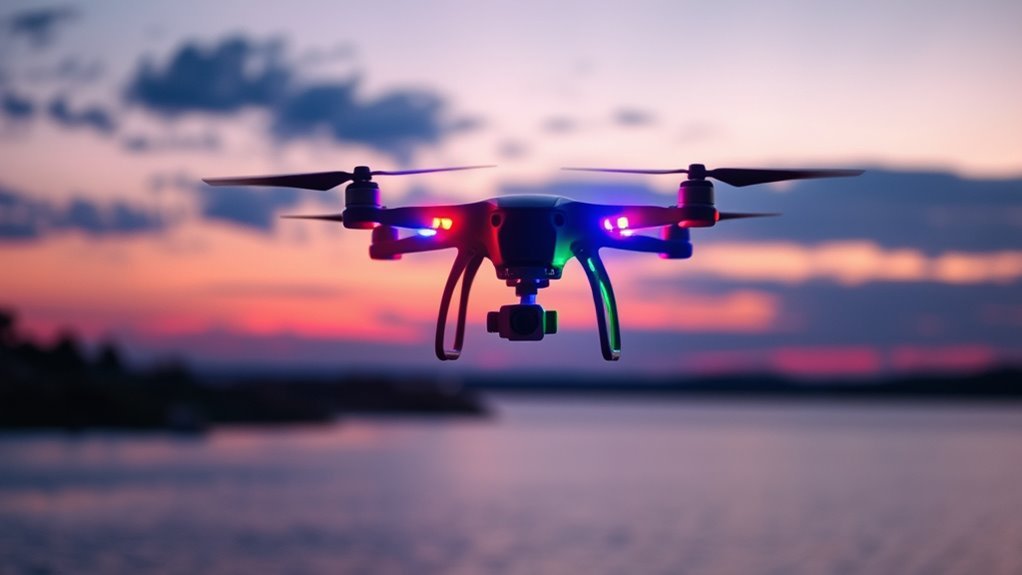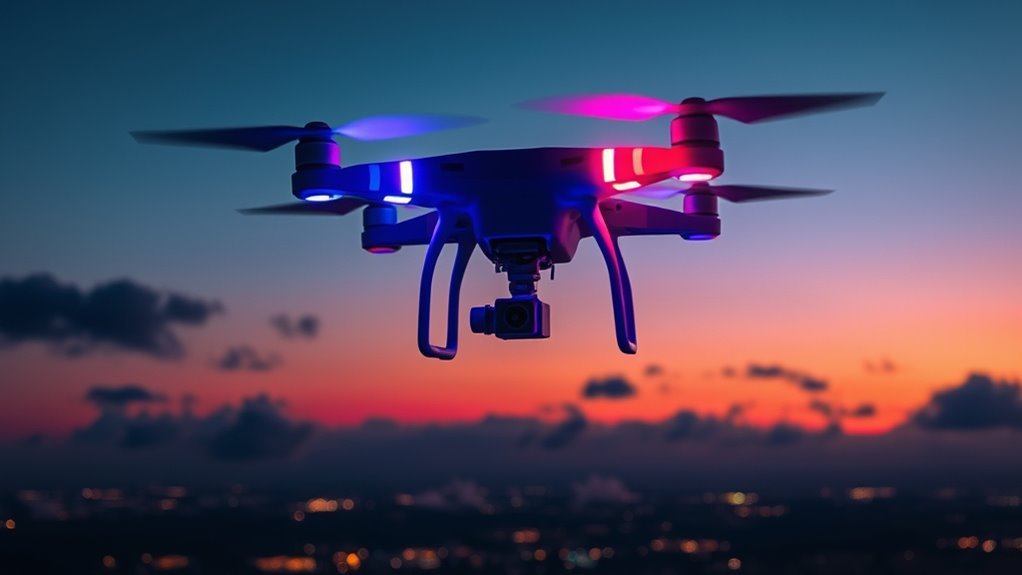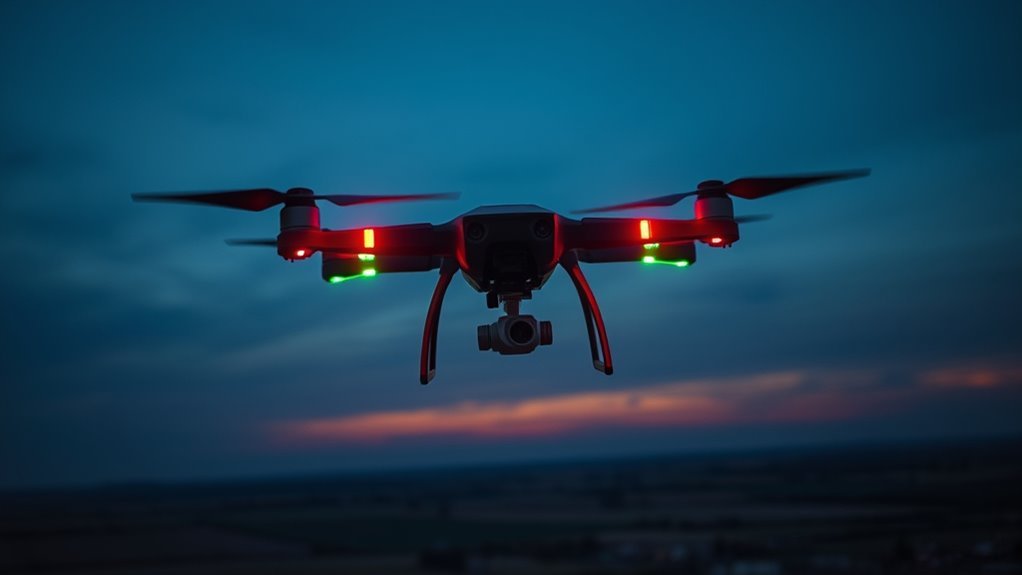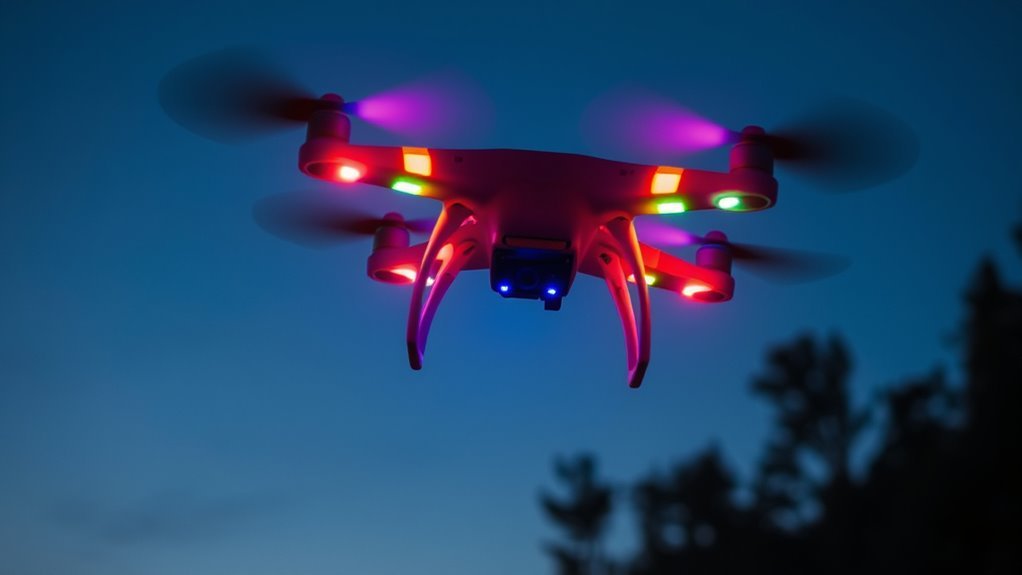Drones use flashing colors to convey important status information. Red lights usually indicate critical alerts, such as low battery or malfunction, while green lights signal orientation and readiness for takeoff. Yellow lights act as caution signals, and blue lights suggest operational modes. Recognizing these colors helps you navigate safely and confidently. Staying aware of what these colors mean enhances your flying experience and can prevent accidents. Discover more about the significance of each light and how they affect your flight.
Overview of Drone Lights

Drones are equipped with various lights that serve important functions, making them more visible and helping with navigation. Understanding these lights is essential for anyone using drone technology, especially when flying in crowded areas or near nighttime. These lights not only enhance visibility but also comply with safety regulations, ensuring that your drone can be easily spotted by others. For instance, green lights typically indicate the front, while red lights indicate the back, aiding in orientation during flights. Furthermore, knowing how these lights function can help you avoid potential hazards in the air. Embracing this knowledge allows you to fly with greater freedom and confidence, enjoying the vast possibilities that drone technology offers while staying safe and responsible. Additionally, utilizing intelligent flight modes can further enhance your navigation experience by providing automated assistance during flight.
Common Flashing Color Patterns

While understanding the basic colors of drone lights is important, recognizing the common flashing patterns can greatly enhance your flying experience. Many drones use specific color variations to convey different states or actions. For example, a rapid alternating flash between red and green might indicate that the drone is in a low battery mode, while a slow, steady blink often signals that it’s ready for takeoff. Pattern recognition is key here; by observing these sequences, you can quickly assess your drone’s status. Additionally, some drones may flash in unique patterns to signal specific actions, such as returning home or entering a follow-me mode. Familiarizing yourself with these common patterns will empower you to fly with confidence and clarity.
Meaning of Red Lights

When you see red lights flashing on your drone, it’s essential to understand what they signify. These lights play a vital role in ensuring red light safety and awareness. Here are some key points about red light significance:
Flashing red lights on your drone indicate critical alerts, low battery, or emergency protocols, ensuring safety and awareness.
- Low Battery: A flashing red light often indicates your drone’s battery is running low.
- Critical Alerts: It may signal an urgent issue, like a malfunction or loss of connection.
- Emergency Mode: Red lights can mean your drone is entering a safe landing protocol.
- Visibility: They help others recognize your drone’s location, especially in low-light conditions.
- Regulatory Compliance: Some regulations require red lights for safety during night operations.
Understanding these signals will enhance your flying experience and keep you and others safe.
Understanding Green Lights
When you see green lights on a drone, it’s essential to understand what they signify. These lights not only enhance visibility during night flights but also indicate the drone’s takeoff status and battery level. Knowing these signals can help you operate your drone safely and effectively.
Night Flight Visibility Importance
Understanding the importance of night flight visibility is essential for safe drone operation, especially when it comes to recognizing the significance of green lights. These lights play a crucial role in ensuring night safety and adhering to visibility regulations. Here’s what you should know about green lights:
- Indicate Position: They show the drone’s orientation.
- Enhance Visibility: Bright green lights make your drone easier to spot in the dark.
- Signal Compliance: They demonstrate adherence to aviation regulations.
- Prevent Collisions: Clear visibility reduces the chance of accidents with other aircraft.
- Boost Confidence: Knowing your drone is visible helps you fly with peace of mind.
Signal for Takeoff Status
As you prepare for takeoff, the green lights on your drone serve a critical purpose beyond just visibility. They signal that your drone is ready for flight, guaranteeing you follow essential takeoff procedures and safety protocols. Understanding these indicators can enhance your flying experience and guarantee a smooth launch.
| Light Color | Meaning | Action Required |
|---|---|---|
| Green | Ready for takeoff | Initiate takeoff |
| Flashing | Pre-flight checks ongoing | Complete checks |
| Steady | In flight | Maintain altitude |
| Off | Not ready for takeoff | Review issues |
Embrace the freedom of flight while respecting these signals, and your drone adventures will be both safe and exhilarating.
Battery Level Indication
Drones often use flashing green lights to communicate their battery status, which is essential for ensuring a safe flight. Understanding these signals helps you manage your drone’s power effectively and maintain peak battery health. Here’s what those green lights typically indicate:
- Solid Green: Battery is fully charged.
- Flashing Green: Battery is at a healthy level.
- Rapid Flashing Green: Battery is getting low; prepare for landing.
- Slow Flashing Green: Battery is moderately low; monitor usage closely.
- No Light: Battery is critically low; the drone may shut down.
Significance of Yellow and Blue Lights
While you might not realize it, the colors of a drone’s lights play an essential role in communication and safety. The yellow light meaning typically indicates a warning or caution. When you see this light, it’s a signal to be alert, whether you’re flying or observing. On the other hand, the blue light purpose is often associated with status or operational readiness. It can signify that the drone is in a specific mode or functioning correctly. Understanding these colors helps you navigate the skies more confidently and guarantees a smoother flying experience. By recognizing the significance of yellow and blue lights, you’re better equipped to appreciate the intricate language drones use to communicate essential information.
Implications for Drone Operators and Pilots
Understanding the meanings behind drone light colors is essential for operators and pilots to guarantee safe and effective flight. Recognizing these signals can help you navigate within drone regulations and enhance pilot safety. Here are some key implications for you:
- Different colors indicate specific actions or statuses.
- Flashing lights can signal emergencies, requiring immediate attention.
- Consistent awareness of light meanings promotes safer interactions with other aircraft.
- Adhering to light color guidelines helps maintain compliance with local regulations.
- Understanding these colors can boost your confidence while flying.
Frequently Asked Questions
Can Drone Colors Change Based on the Model or Manufacturer?
Yes, drone colors can vary based on the model or manufacturer. Different manufacturers often have unique color schemes, and the significance of those colors can differ, impacting how you perceive their functionality and design.
Are Flashing Colors Universal for All Drone Types?
Flashing colors dance like starlight in the night sky, but they aren’t universal. Different drones use varied signals for safety and color recognition, so knowing your model’s language is essential for safe, informed flying.
How Do Weather Conditions Affect Drone Light Visibility?
Weather conditions can greatly impact your drone’s visibility. Rain, fog, or snow create visibility challenges, making it harder to see flashing lights. Always check the weather forecast before flying to guarantee a safe experience.
Do Recreational and Commercial Drones Use the Same Color Codes?
Recreational and commercial drones often follow different regulations regarding color signaling. While both might use similar colors, commercial drones’ signals are typically more standardized to guarantee safety, whereas recreational drones can vary based on personal preferences.
What Should I Do if My Drone’s Lights Malfunction?
If your drone’s lights malfunction, it’s like a car with a flat tire. Start with drone troubleshooting tips, checking connections. Consider light replacement options if needed, ensuring you regain full control and enjoyment of your flying experience.

